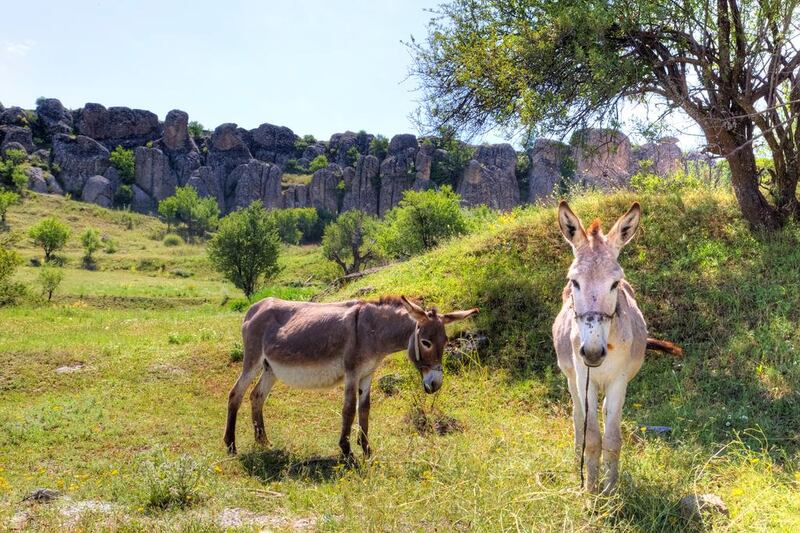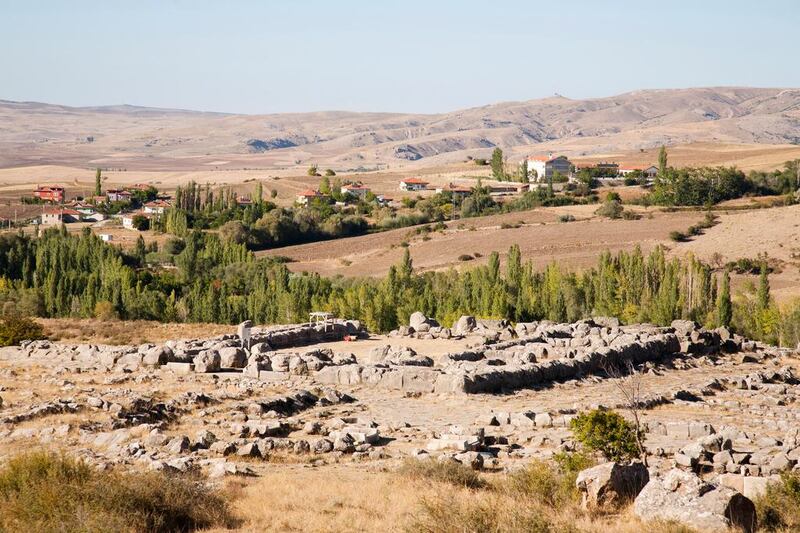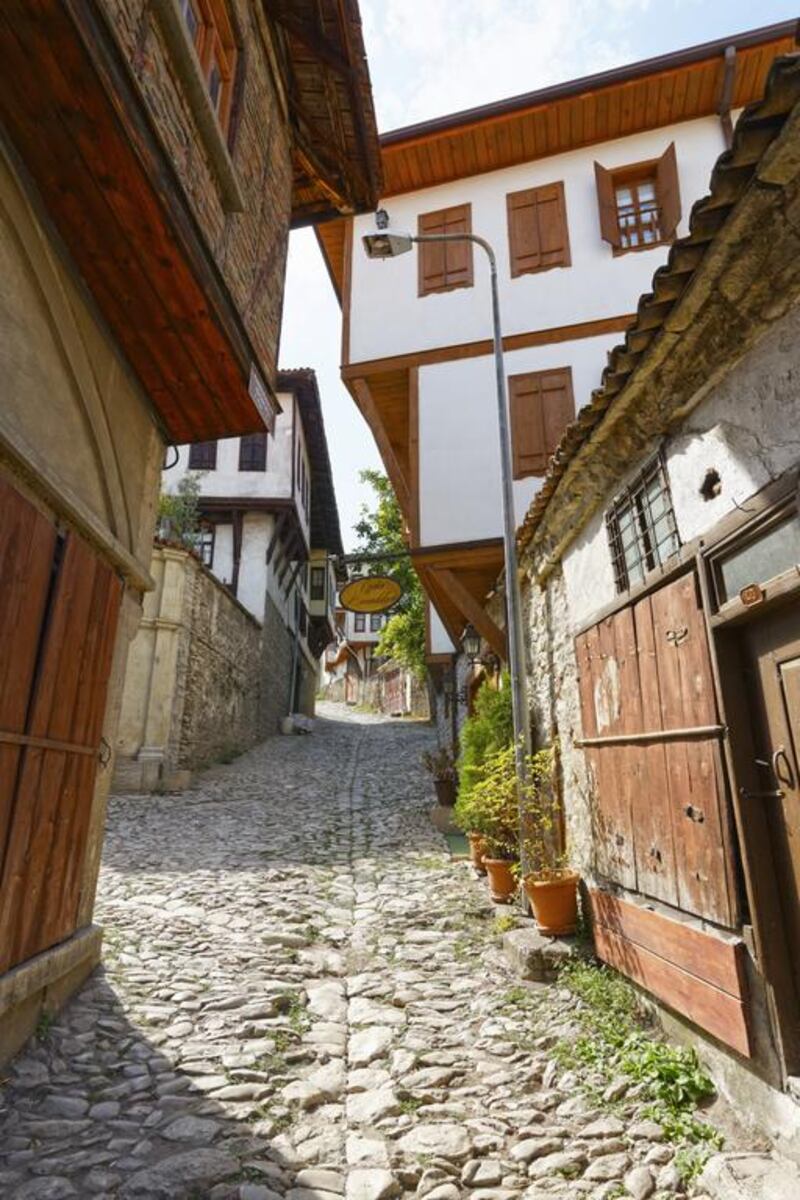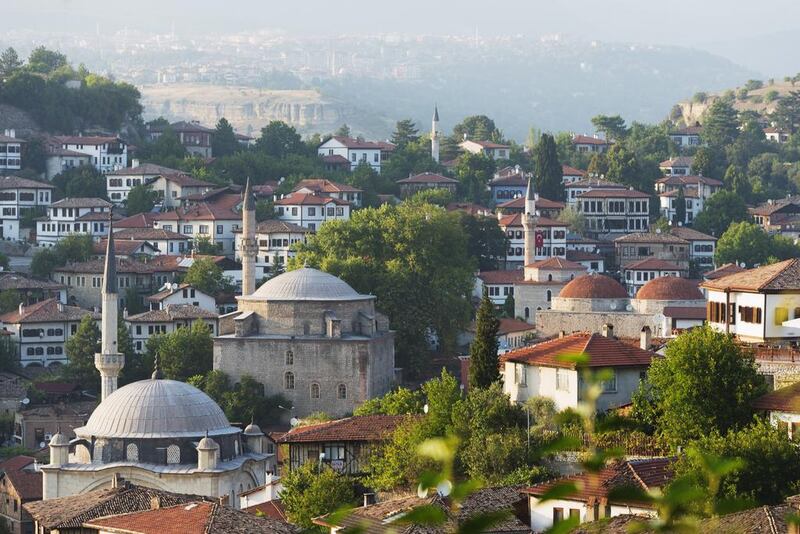The passing of time hasn’t been kind on these walls. Just a few hours’ drive away, along the benign Mediterranean coast, sit 2,500- to 3,000-year-old temples, dedicated to long-forgotten gods, which are so perfectly preserved they appear to have been built just months earlier. Here though, on this harsh mountain plateau, things are different. Enormous walls that withstood anything the armies of the ancient world could throw at them are now just hilltop boulders, almost indiscernible from nature’s hand. Perhaps it’s the climate, which is nothing if not extreme, that has rendered these ruins mere hazily recalled memories of the past. For half the year, the sun beats down with enough energy to sap the lifeblood from rocks, and in winter the landscape hibernates under a tomb of ice and snow. Year-round the wind blows here with anger and clouds tempt with rain, but rarely deliver. The result is a highland desert steppe where trees are an unlikely blessing and a life of nomad tents is only a few generations past.
When I’d first contemplated coming to Turkey, I’d decided I wanted to experience a different side than that of glossy beach resorts and Istanbul’s architectural wonders. I wanted to see a part of Turkey often overlooked by other visitors. An area where I would be forced to bend my tongue into trying to communicate in very broken Turkish. On the high plateaus of central Turkey, I found exactly what I was looking for. Even in Ankara, the unlikely capital of the country and an almost entirely modern creation of the last 80 years (although a small settlement has, in some form or another, existed here for at least 3,000 years), I hadn’t come across more than a handful of other visitors. It was a big change from Turkey’s “other” city, where I’d often found myself enduring queues an hour or more long to enter the more famous tourist sites. Of course, one of the reasons coachloads of other tourists don’t swarm over the sites of central Turkey is because, on paper at least, they can come across as less impressive than in other parts of the country. The ruins here are just that: ruins, rather than perfectly preserved complexes, but what these hillsides of half-buried monuments have, which other ancient sites in Turkey often lack, is an abundance of romance.
If you need some kind of indication as to just how thick the pages of history have been layered across central Turkey, then a half-day in Ankara’s Museum of Anatolian Civilizations will leave you feeling like an insignificant dot in the passage of time. Its halls and galleries are bursting with statues, jewels, monuments and everyday items from days long since past. That this museum, which is easily one of the best in Turkey, is so treasure-packed is hardly a surprise when you consider the history of central Turkey. This is the land where the Hittites and Phrygians stood proud, where King Midas turned nothing into gold, where Alexander the Great (or the Accursed, depending on your point of view) proved that the famously impossible to untangle Gordian knot could be undone by merely using a sword to chop it in half, which, in our lowly opinion, makes him a cheat, not a divine ruler of half the known world. It is here that one of the world’s oldest wooden structures can be found, along with some of Turkey’s finest Islamic architecture, outside of Istanbul. It’s even where the still-revered figure of Atatürk forged the idea of the modern secular state of Turkey. In summary, this overlooked area of Turkey is the very soul of the country.
Of all the ancient sites dotting central Turkey, the one that left the strongest impression on me was isolated and mountainous Hattusa, the former capital of the much-feared Hittites. Back in its long-distant glory days, Hattusa was home to about 15,000 people and controlled a swath of territory that stretched from Syria to Europe.
Modern Hattusa, though, is just a small farming village, home to a few hundred souls and plenty of thick-wool sheep. Leaving the warmth of my guesthouse early in the morning, I walk alone over a cold, wind-scarred plateau, where the first spring flowers are just starting to call bumblebees to attention, to arrive at the tumbledown gates of a city guarded by the stone-carved faces of a pair of snarling lions. Passing through this monumental gateway, I find a hillside littered with the remnants of fortresses and traders’ houses, temples, ceremonial walkways and long sections of city walls, the scale of which still dazzles even 3,000 years after they were first erected. For a full day I explore this vast site. I shelter from the cold in the leftovers of palaces, which might once have hosted royal banquets, and run my fingers over the faded reliefs of rock-carved gods and goddesses. All the while, bar the odd shepherd with his flock, I see no other visitors and could let my imagination run wild with thoughts that these ruins belong to me and me alone.
Not all of central Turkey is bleak and ruined, though. In the north of the region, buckled mountains lead to warm and wet valleys busy with apple, cherry and apricot orchards. This is one of the most fertile parts of the country and home to some of the most picturesque villages, including Safranbolu. This small and now slightly twee town consists of delightfully restored, half-timbered Ottoman-era konaks, or mansions, and quaint sweet shops with window displays bursting with rainbow-coloured Turkish delight and the local speciality yaprak helvasi (layers of gooey white halva with walnuts). The beauty of the town’s buildings indicate that this must have once been a wealthy place, and there’s a clue to where this wealth came from in its name.
Safranbolu, which once sat on important trade routes from the nearby Black Sea coast, was long famed for the excellence of the saffron that grew in these parts. When tastes moved on, and other suppliers of this rarest of spices appeared, Safranbolu’s days of import started to fade. In recent years, though, it has started to benefit from something of a resurgence in interest with the wealthy of Ankara making a beeline for the town over the weekends. They come today not for the spice, but for the laid-back vibes, the beauty and the food, because Safranbolu is as pretty as a chocolate-box picture and its offerings taste just as good.
In its lazy cafes and restaurants, you can enjoy some of the best food in all of central Turkey, including a few other local specialities to go alongside the yaprak helvasi – treats such as cevizli yayum (macaroni with walnuts) and zerde (saffron dessert).
The southern city of Konya, which is just two hours by high-speed train from Ankara, is yet another change of pace. This large city that feels so small is a forward-looking economic powerhouse, overlaid in tradition and often devoutly religious. Everything here is focused on the Mevlâna Museum, which turned out to be less a dusty museum and more a magnet of religious belief and centre of pilgrimage. It was here that the 13th-century mystic philosopher, poet, writer and teacher of tolerance, Rumi, otherwise known as mevlâna, helped establish a brotherhood called the Mevlevi, or whirling dervishes, whose endless spinning top “dance” represents a divine union. Today, over 1.5 million pilgrims and interested visitors come to the Mevlâna Museum each year to pay their respects to Rumi, and the complex in which his tomb is found is soaked in a constant awe of devotion and respect. Around the complex, I find a vast plaza filled with hawkers and pilgrims. Beyond stretch noisy bazaars and parks filled with springtime tulips, all of which help give the city a carnival-like atmosphere.
As inspiring as Hattusa is though, as cuddly gorgeous as Safranbolu might be and as humbling as Konya can be, it is in the quiet hills and valleys surrounding the latter that I really discover Turkey at its most exotic. I hire a bright yellow taxi for the day and go to a hilltop village called Gökyurt, an hour or so out of Konya. At first glance there is nothing special about the place, and donkeys and goats seem to outnumber humans. I walk the cobbled lanes of the village for a while before one grey-mustachioed old man in a flat cap calls me over. He is sat in the doorway of his house, and the moment the greetings are over he invites me to drink Turkish tea with him. Afterwards I am led out of the village, over a muddy field or two and pointed, with pride, down to the valley floor. Here the cliffs have been, over aeons of time, weathered into turrets and spires and then carved by his ancestors’ hands into a series of cave dwellings and medieval churches. It is like a miniature Cappadocia, one of Turkey’s most popular draws, but without the tour buses and hot-air balloons. In fact, there is nothing much whatsoever here. Just me, an old farmer and a donkey or two, but this simplicity is fine with me, because finally it feels as if I have arrived in the Turkey I had been searching for.
Read this and more stories in Ultratravel magazine, out with The National on Thursday, May 19.
travel@thenational.ae









